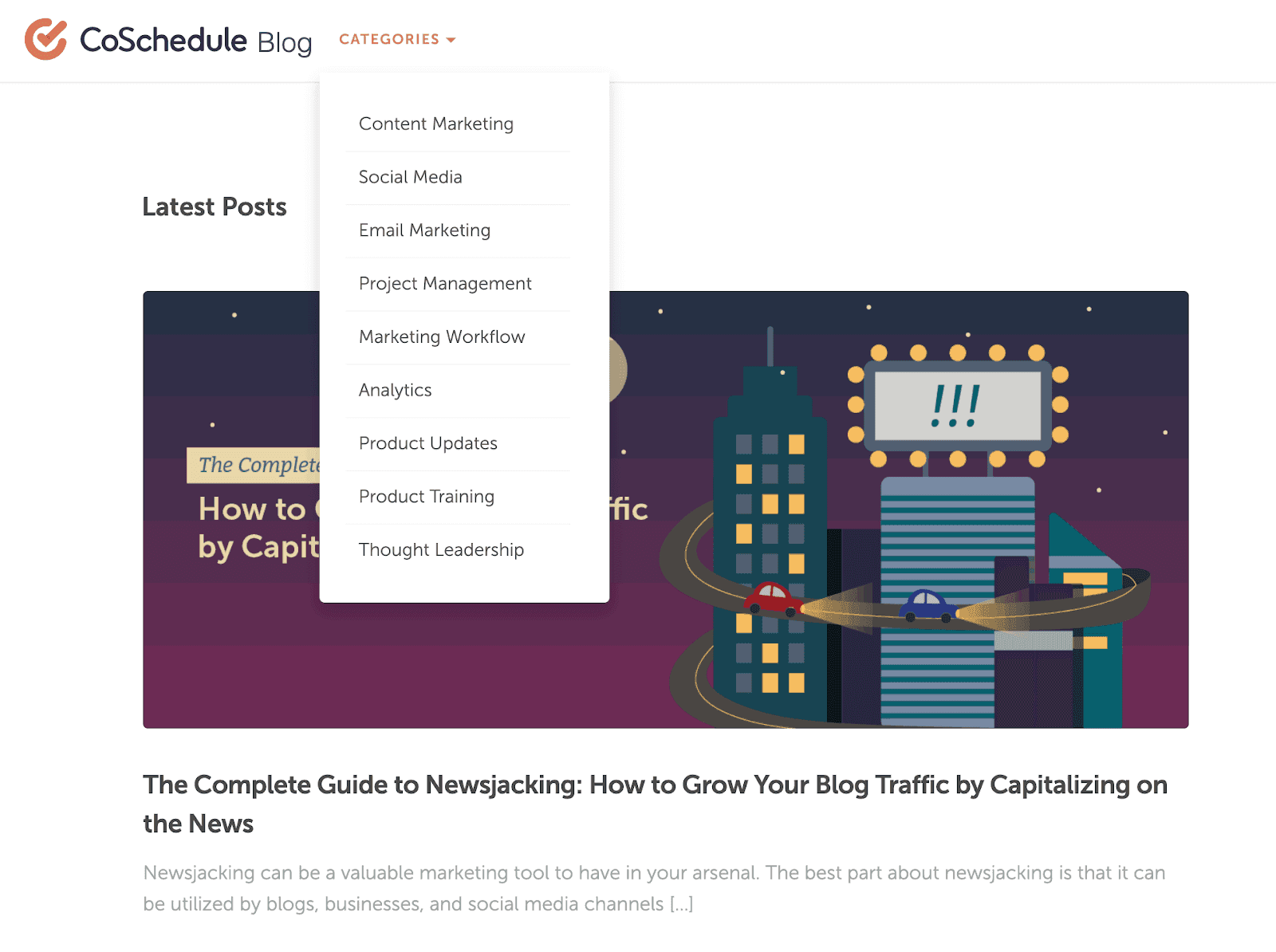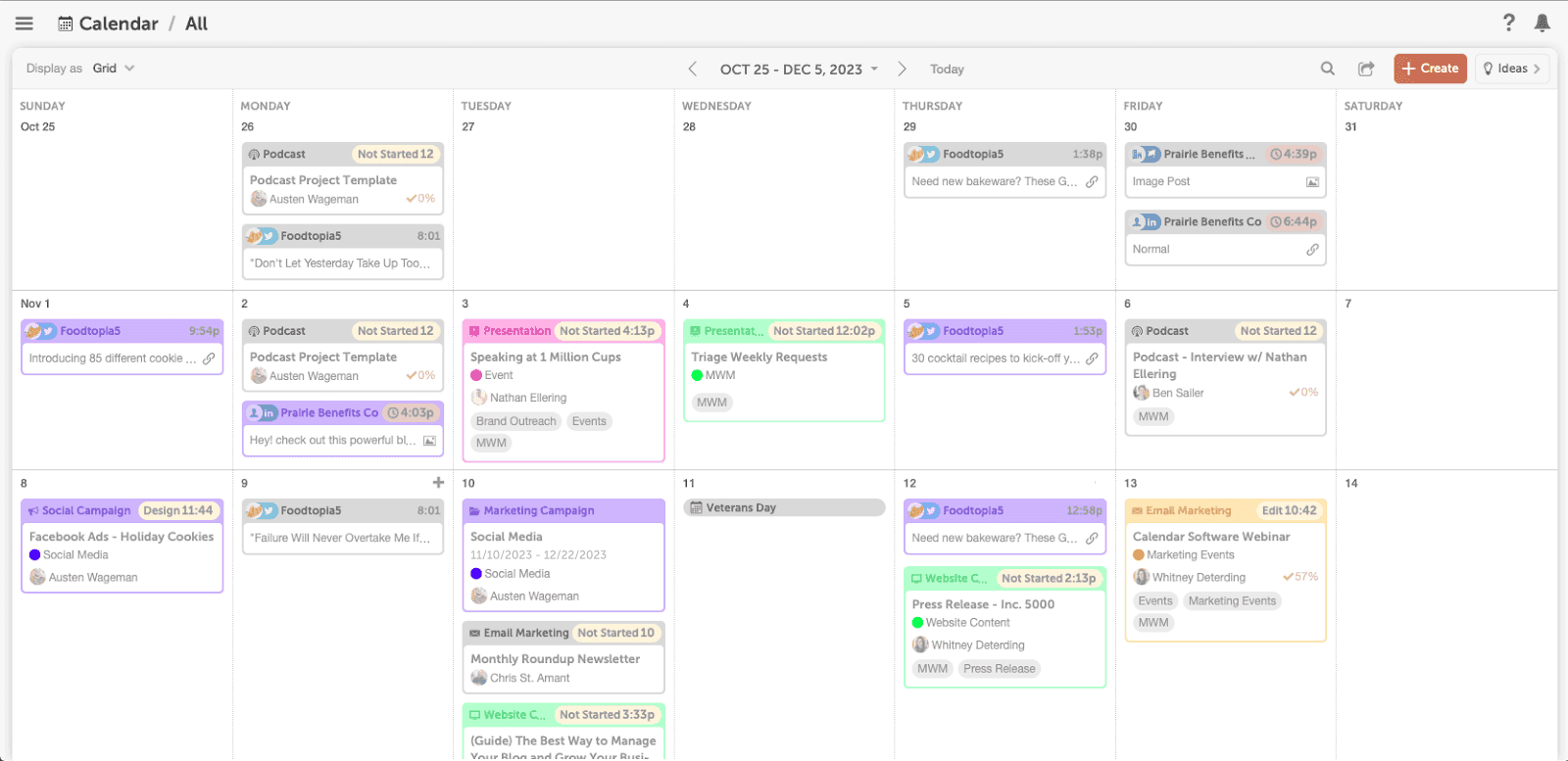Marketing teams often operate in chaos. Projects and tasks live in team members’ heads, in notebooks, on sticky notes, in emails, and on whiteboards. Managers struggle to keep track of campaigns and results, and it’s hard to know how one person’s work affects someone else’s progress.
Want to hit marketing and revenue goals? It’s near impossible to do so with such a fragmented, disorganized marketing setup.
There’s a solution: a single, centralized marketing calendar to rule everything.
Think: marketing campaigns, the creative work that fuels them, day-to-day tasks, dependencies, visual assets, edits, topic ideas, and beyond. All the work that needs to happen to see success—it all lives in this calendar.
With it, you’ll deliver better marketing projects and ship them faster. You’ll spend less time searching for the right piece of information, due date, or file, and more time creating the right content for your ideal audience.
What is a Marketing Calendar?
A marketing calendar is a tool for planning and organizing your marketing projects in one place.
It’s a roadmap for all your marketing activities. It’s the single source of truth for all functions in the marketing team.
A marketing calendar answers questions like:
- What marketing campaigns are we working on? This can include big product launches, holiday promotions, events like conferences and webinars, social media campaigns, and other brand initiatives.
- What marketing projects are we working on? If campaigns are groups of projects, then projects are specific types of content, collateral, and assets marketers publish such as newsletters, blog posts, landing pages, brochures, and more.
- Who is in charge of each project and task? Marketing calendars help you avoid the “I thought you were working on that” downfall.
- When are your projects due? No more scrambling in the final hours before the deadline; the calendar will allow you to plan in advance and ship excellent work on time.
Ever heard of planning fallacy? Even if you don’t recognize the term, you’ve almost certainly experienced it: you underestimate the time it will take you to complete tasks, even though previous tasks have already taken you and the team longer than planned.

A marketing calendar neutralizes this challenge. By organizing all your marketing efforts in one place, you can use data from previous projects to fuel your planning for upcoming projects
Removing the stress and chaos from your content operations will pay off. Your team will create better deliverables, you’ll be more focused, and you’ll hit greater marketing and business goals.
What Does a Marketing Calendar Look Like?
Marketing calendars can take many shapes and formats. Here are a few to consider:
- CoSchedule Marketing Calendar Free, Marketing Suite, and similar marketing calendar apps. We’re biased, but dedicated marketing calendar apps are the secret weapon of high-performing marketing teams. They’re flexible, shareable, and packed with clarity and action.
- Spreadsheets. A great way to keep your marketing calendar digital without a specialized marketing tool.
- Printable calendars. Printable PDF calendar versions are a great way to start bringing your marketing projects together. As your team grows and picks up pace, you’ll likely want a digital version to share the calendar and make changes more easily.
- Google Calendar. You can build an editorial calendar in Google Calendar with color-coding for different campaigns, recurring slots for weekly content and more.
Your marketing calendar will give you an instant overview of ongoing campaigns, tasks that support them, deadlines, formats, and potential bottlenecks.
Download Your Marketing Calendar Templates
If you’re creating your first calendar, and aren’t ready to try a software-based solution, then you may want something simple and no-cost to get started. These four Excel-based templates will make it easy to set up a calendar your entire team can share and use:
- Marketing Project Calendar: A simple calendar for planning a single piece of work.
- Marketing Campaign Calendar: A single template to organize one campaign with multiple projects.
- Quarterly Marketing Calendar: A template that’s a bit more robust if you plan one quarter at a time.
- Traditional Marketing Calendar: One holistic calendar to plan every project and campaign in one place.
How to Use Your Calendar to Turn Strategy Into Execution
Best marketing calendars are based on powerful marketing strategies. This way, you can deliver the right message to the right people on the right channel, and bring traffic, leads, and revenue.
Here’s how to execute your marketing strategy with a content calendar.
Step 1: Turn Your Marketing Strategy Into Real Content You’ll Create
How do the words “marketing strategy” make you feel?
Do you instantly imagine a long, dry document you throw into your drawer and never look at again? Or do you picture a daily action plan for you and the team, one you can iterate on if something changes?
The latter is the dream, but many teams get stuck with the overwhelming, 30-pages-long strategy doc that gets outdated within weeks.
The better way forward is easier than you think, but it’s crucial to switch from over-strategizing to real-time action.
Garrett Moon, CoSchedule’s CEO, calls this a ‘results or die’ approach that’s typical for startups. Why startups? Because they’re doing everything they can to stay in business. They have to execute, embrace their failures and learn from the data, and keep executing.
Another downfall of overthinking your marketing strategy is the number of assumptions it requires you to make:
Marketing comes with assumptions: assume methods used to get the message out will work; assume there’s the right mix of email ads; assume messages are right; assume the timeline is correct. Ever realize how much you are guessing?
There’s an easier way. To start building and executing your strategy, you only need three building blocks:
- Knowing your audience: Data is gold. Use your customer data, survey your customers, dig into sales and customer support conversations, hear your target customers out on social media.
- Creating content: The more content you create, the more feedback to it you’ll have. Measure your content’s impact to understand what works.
- Starting small: Instead of starting with long ebooks, massive article series, or video masterclasses, start with minimum viable content. Huge content campaigns require lots of resources and carry big expectations—neither of which will help you ship and iterate content quickly.
This startup approach to your marketing plan—and calendar—also looks like this:
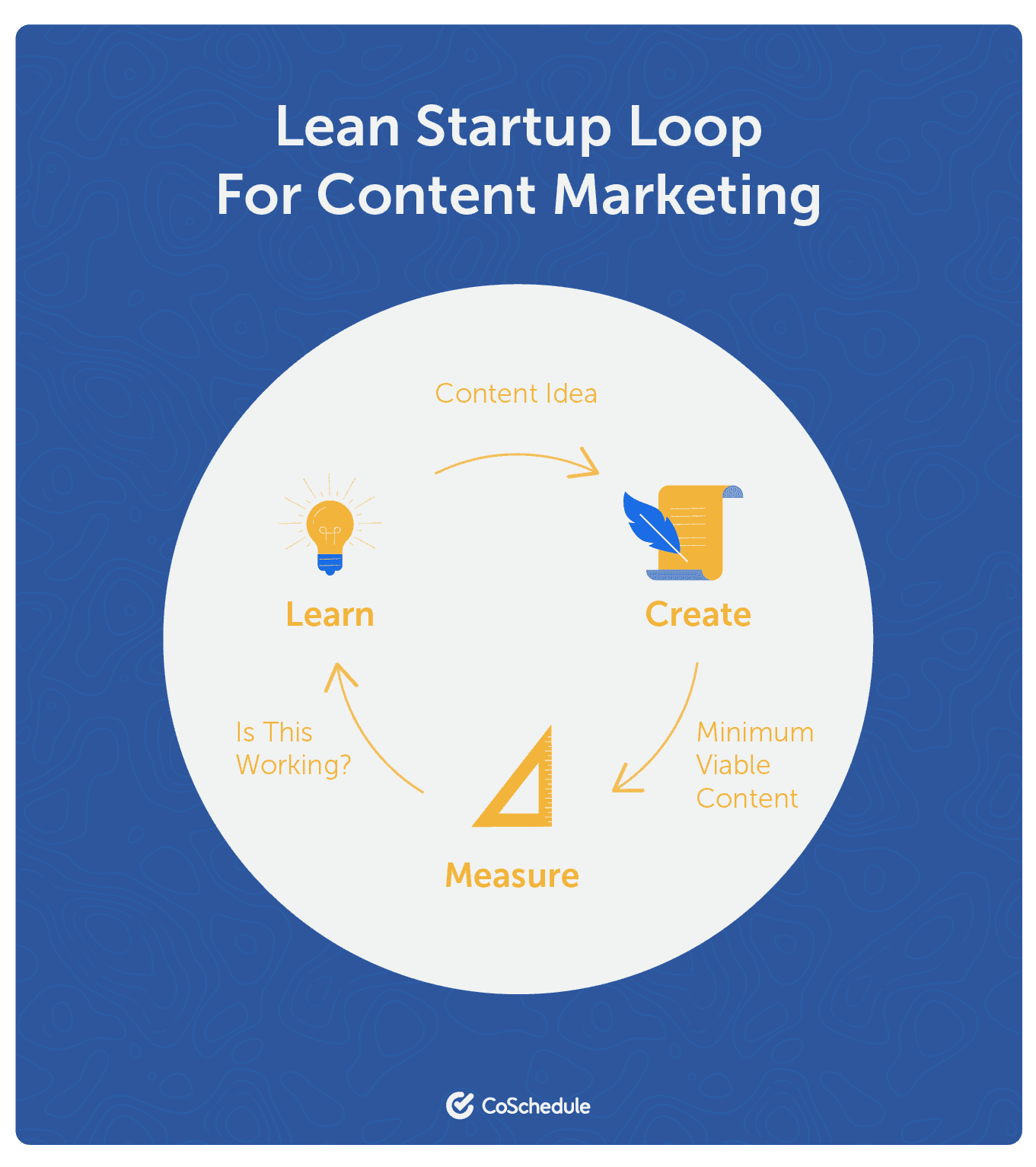
On a day-to-day basis, your minimum-viable marketing strategy will look like this:
- Create your content.
- Share it with your audience.
- Measure what’s working (and what can be improved).
- Learn what content to create and how to best distribute it.
- Plan more content like your best-performing projects.
Want a list of powerful questions to guide your marketing strategy? Use these from Garrett Moon’s book, 10x Marketing Formula
- What are you and your team really good at? What can you do better than anyone else?
- What are your competitors doing that’s similar? What are some patterns you could disrupt?
- What’s in it for your customer? This should be your primary guide.
- Are there people in your customer base or audience your content is currently underserving?
- What have you and your team created already that you’re most proud of?
Step 2: Define Team Roles and Who Does What
Next step is to move your action items to your marketing calendar. But before you do that, you need to define which team member is in charge of which tasks and projects.
In other words: you can have the best marketing calendar in the world, but projects on it will only come to life if they’re someone’s responsibility.
Your roles will depend on your team size. Here’s a list you can start with if you have a small team:
- Team lead: helps with planning, editing, publishing, and distributing
- Writer: turns content ideas into a piece of content your audience will love
- Designer: takes the writer’s work to the next level (as video, podcast, graphics, etc.)
If you’re aiming for a larger content marketing team, you may consider this structure:
- Content marketing strategists: helping the entire marketing team understand your audience, the topics, and how you’ll measure success
- Content strategists: directing the team to execute the plan
- Idea contributors: not limited to just your marketing team
- Content writers: content developers, supported by content editors
- Content editors: refining content created by writers
- Content promoters: responsibilities include link building, social media, newsletter promotion, and more
- Graphic designers: building visual assets including website images, blog graphics, social media graphics, ebook covers, infographics, etc.
- Community managers: managing the engagement around your content
- Content analysts: reviewing traffic, social shares, engagement, search rankings, and conversions to determine successful content
- Videographers/video editors: recording and editing video for social media, YouTube, your website, and more
Remember the option to hire in-house or work with external contractors for certain roles (like writing, graphic design, and video editing). In both cases, editorial guidelines will help you maintain high content standards.
Make everyone aware of the roles you’re building into the team and get on the same page about capacity.
Then, use the marketing calendar to manage projects, communicate, oversee workloads, and maintain an efficient workflow.
Recommended Reading: How To Craft An Effective Communications Plan In 10 Quick Steps
Step 3: Define Topic Themes and Campaigns
By using themes for your content, you’ll end up with virtually unlimited content ideas.
Content themes are larger groupings of the topics your business focuses on.
You can use them as placeholders in your marketing calendar and rotate them weekly, every two weeks, or monthly. They’re also a great starting point for brainstorming topics and ideas.
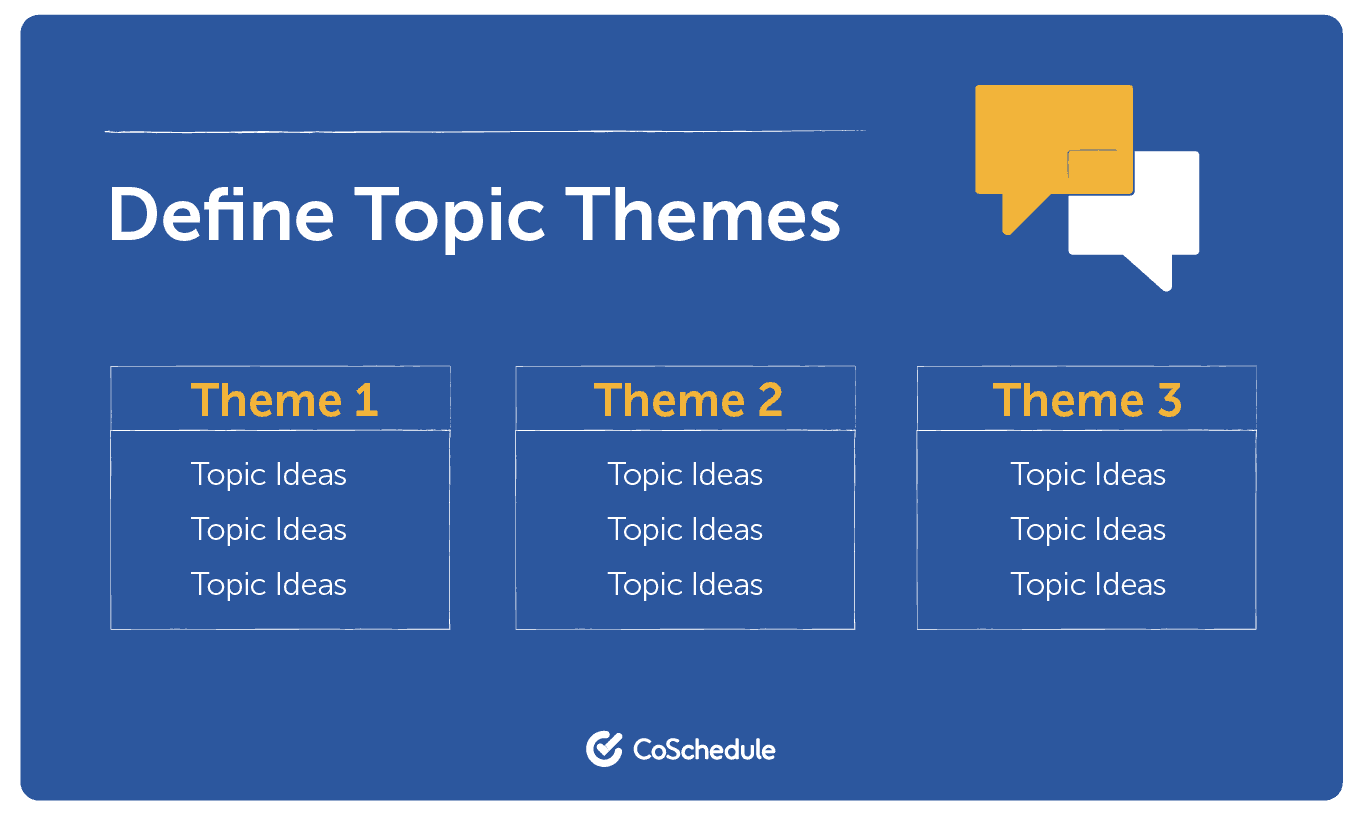
You can see examples of topic themes on our blog, listed as categories:
Whatever your industry or business model, content themes will work for you. Take these examples:
- Event planning: conferences, trade shows, fundraising events, festivals
- Email marketing software: strategies, ecommerce, newsletters, deliverability, metrics and reporting
- Fashion brand: fit and care, sustainability, style inspiration, tips by season
Your themes can also include content collaborations like podcasts, guest posts, interviews, expert quote roundups, case studies, and competitions.
Brainstorm a list of themes and use them to flesh out your marketing calendar with campaigns and recurring marketing activities. You can plan for as long ahead as you wish, but keep in mind that the more data you collect, the better your plan will be.
That’s why it’s valuable to plan for shorter periods upfront as it means you can easily tweak your plan based on how your content performed.
Maximize Your Marketing Calendar With AI-Powered Tools
Unlock the full potential of your marketing calendar with the cutting-edge AI-powered tools offered by CoSchedule. These innovative solutions are designed to streamline the planning, organization, and optimization of your marketing efforts.
- AI-Editor: Experience the world’s first Collaborative AI-Editor, Hire Mia, which multiplies your marketing output by assisting in content creation and editing.
- Headline Studio: Craft compelling headlines that drive engagement with Headline Studio, an AI-powered headline writing tool.
- Social Calendar: Schedule, publish, and measure the impact of your social media content with ease using Social Calendar.
- Content Calendar: Gain total visibility over all your marketing tasks, projects, and campaigns with Content Calendar.
- Marketing Suite: Coordinate your marketing processes, projects, and teams more efficiently with Marketing Suite.
By integrating these AI-powered tools into your marketing calendar, you not only save time but also enhance the effectiveness of your content strategy. This leads to improved SEO, as your content becomes more targeted, more engaging, and more likely to resonate with your audience.
5 Steps to Get Started With Your Own Marketing Calendar
Ready for the calm and clarity of a marketing calendar? Follow these five steps to get it.
Step 1: Choose Your Marketing Calendar Tool
Start by choosing your marketing calendar tool. Pick from printable calendars, spreadsheets, a Google Calendar, or a tool like CoSchedule.
For any option you choose, make sure it’s a team-wide decision and approach. If you use a spreadsheet, but your team is relying on a Google Calendar, both calendars will be outdated in no time.
That’s why we recommend a centralized, all-in-one marketing calendar. It brings all of your marketing projects together and is updated in real time—no outdated files and deadlines that fall through the cracks.
Grab our marketing calendar templates or sign up for CoSchedule’s forever-free Marketing Calendar software.
Step 2: Generate Campaign and Content Ideas
Brainstorming content ideas doesn’t have to be an overwhelming process. In just 30 minutes, you can generate powerful ideas for your campaign and topics.
The team at CoSchedule boiled it down to three simple steps:
- Get the team together and get everyone to free-write ideas with no restrictions (in just 10 minutes)
- Rank all ideas 1 (weak), 2 (average), and 3 (exceptional); you can do this silently or out loud
- Double down on the best topics, those you ranked with 3
This is a mighty brainstorming process because it gets everyone into a creative mode, forces them to consider what the audience wants from you, and leverages the power of the entire team.
Recommended Reading: Construct A Creative Strategy That Surpasses Your Marketing Goals
The point is to not limit anyone, nor to get them to brainstorm their ideas out loud. They write them down on a sticky note so they can keep going without judgment.
When you have your list of highest-ranked ideas, note the problem that piece of content solves, as well as any potential headlines and angles.
Step 3: Prioritize Ideas Based on Purchasing Intent
There’s one more way to score your ideas (only the best ones from the previous step!)—purchase intent.
Users reveal a lot about their intent as they ask questions and look for answers. “Email marketing statistics” is a lot broader than “Mailchimp pricing,” and shows us how far from being ready to buy someone truly is.
Marcus Sheridan, a marketing author and speaker, recommends starting with content that generates sales. This is bottom of the funnel content, where customers care about the cost, problems, comparisons, reviews, and best options. Marcus calls these the Big 5.
“Essentially, we have every client rate their planned content (be it blog titles, videos, etc.) on a scale of 1-3. A “3” score means it’s “Buyer’s Content” and therefore marked as most urgent—moving it to the top of the calendar. If it’s a “1” grade, then we’ll wait to produce this content because it’s either a top of funnel question that a buyer may be asking or even an “outside of the funnel” question/subject—meaning that although it may be relevant to the business and buyer, it doesn’t necessarily represent someone who is seriously considering making a purchase right now.”
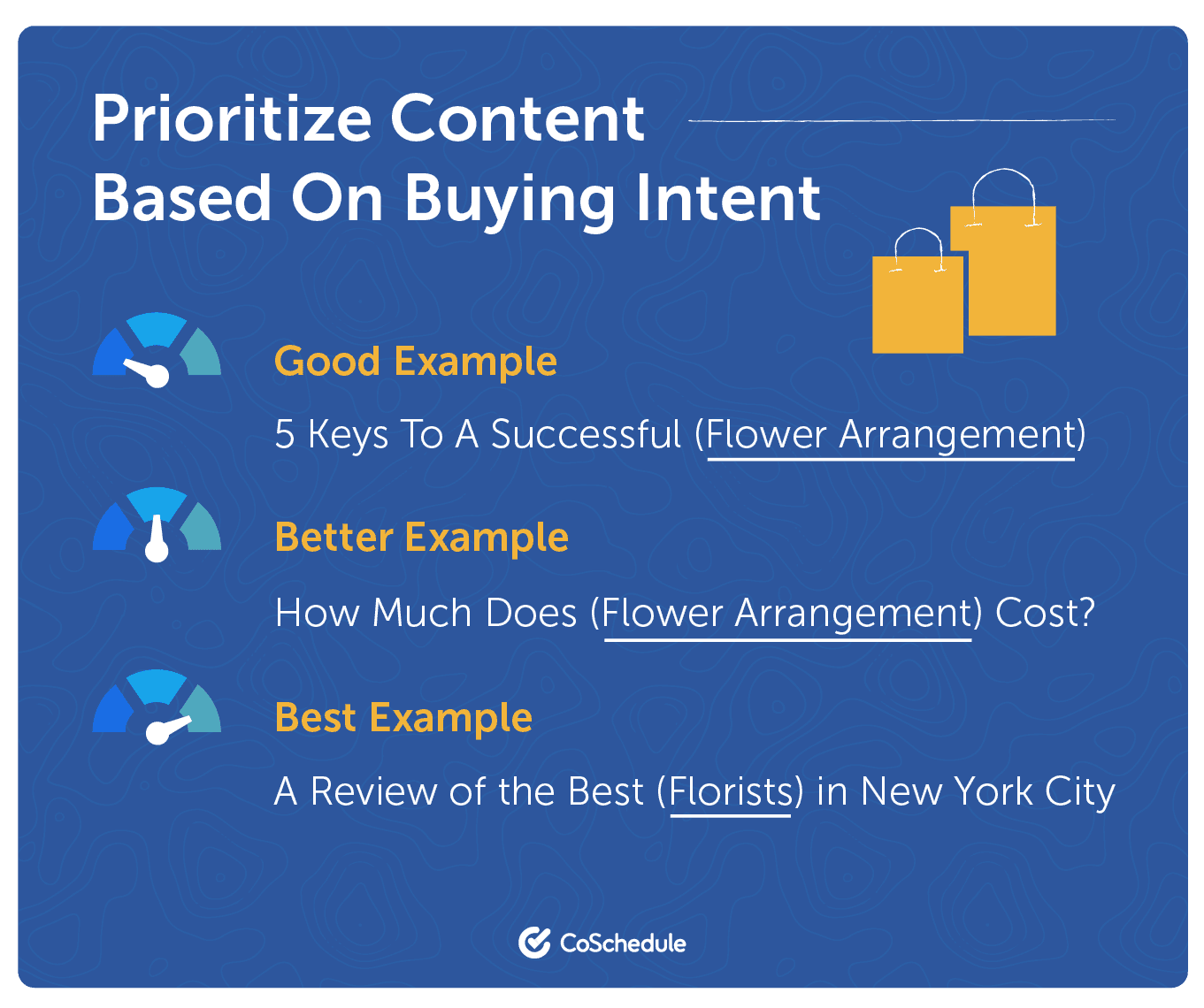
For each of your themes, use the brainstorming process from step 2 and list all your top ideas. Then follow Marcus’ advice and score your best ideas based on how close to the purchase they are.
Step 4: Plan Content For a Week, Month, or Year Out
This is where you populate your marketing calendar with the ideas you generated, ranked, and refined in the previous steps.
It’s the visual representation of your marketing strategy.
It’s entirely up to you to decide how far in advance you’ll plan your content. If you plan for two weeks ahead, stick to your plan, and then plan the next two weeks, that’s better than planning for six months ahead and falling off track quickly.
Make this sustainable for you and your team members. Combine what you learned about your audience with what you can reasonably achieve with your team.
As Joe Pulizzi of Content Marketing Institute said more than a decade ago:
One thing is certain: if you don’t keep an editorial/marketing calendar, the content doesn’t get done.
Step 5: Actually Create the Content
Then, it’s time to get to work. With the calendar in place, the final step is to bring your marketing strategy to life.
Your marketing calendar will tell you and your team what to focus on each week and day, with details like:
- The topic
- The campaign a piece of content belongs to
- Formats and channels
- Deadlines
- Dependencies and approvals
- Content themes
- Team members involved
- Current status
This makes it easy for you to check in with your team regularly and make a game plan for the week—and tweak it if anything more urgent comes up.
Common Questions About Marketing Calendars
Do you have questions about what your marketing calendar should and shouldn’t include, or the best type of marketing calendar you can choose?
We have answers.
Q: What should go on a marketing calendar?
Everything! If there’s a format or a channel that supports your marketing effort—and someone on the team is in charge of it—it goes on the marketing calendar.
This includes blog posts, ebooks, guest posts, white papers, podcasts, email newsletters, videos, limited-time promotions, holiday campaigns, and social media posts.
It’s best to start small, especially if you’ve never used a marketing calendar, but over time all of your projects will ideally be mapped out on the calendar.
Q: Can I plan events on a marketing calendar?
Absolutely. Events involve many moving pieces, and a marketing calendar will help you keep them all on track in one central place.
You can, and should, manage all the content and marketing assets for the event in the calendar, too. This will keep all the materials for the event up to date and available for everyone involved in just a few clicks.
Q: Which type of marketing calendar is best?
Software like CoSchedule will offer the most power and efficiency, with automation and workflow features built in.
You can see all your marketing projects together, share your progress with higher-ups, track your success, and reschedule projects with ease when plans change. You’ll see your team’s capacity at a glance, eliminate burnout, and make the most of everyone’s zone of genius.
Spreadsheets and other options are a solid way to get started, but remember some of their limitations for when your team grows.
Hit Your Goals With a Marketing Calendar
You’re ready to build a marketing strategy and turn it into reality. No complicated setups or dusty strategy plans in your drawer—just an action plan you can start with as soon as this week!
If you want to give CoSchedule a try, don’t forget to claim your free calendar and see what you can do with a powerful marketing calendar.
This post was updated on December 30, 2021. It was updated again November 18, 2022.
